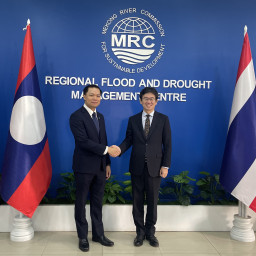Press Statement on Current Mekong Flood Situation
On Friday, 15 August 08 water levels receded in Luang Prabang and receded slightly in Vientiane. They are predicted to fall significantly over the weekend at these stations, although as the flood waters move south it is likely that water levels will reach at least alarm stage in southern Lao PDR, Cambodia and Viet Nam later in the coming week.
The observed peak water level in Vientiane reached 13.68m, which exceeded the 1966 flood level (12.69m) by almost one meter. Prior to this, the highest water level observed was 12.66m in 1924.
Areas of Luang Prabang, Vientiane and Nong Khai have been flooded, as have been rural areas of Lao PDR and Thailand. However, the city centre of Vientiane has avoided inundation. This is because following the 1966 event which flooded large areas of the city a raised earthen dyke was constructed to protect Vientiane. This has managed to contain the 2008 flood water, although water levels did reach the top of the dyke in some areas. Effective emergency works by the government reinforced the dykes with sandbags which avoided significant further inundation. Similar structural and emergency measures have been taken in Thailand.
This current flood is a combination of the following. The northern parts of the Mekong basin have experienced significantly above average rainfall during the first months of the monsoon season which saturated the river catchments, providing increased flood runoff. These conditions resulted in high river levels than usual and were compounded by tropical storm Kammuri over the weekend 8-10 August 2008. Kammuri brought intense and prolonged rainfall to the northern basin. In the case of the flood water that reached Vientiane some 50% originated in China and the rest in Lao PDR from large tributaries such as the Nam Ou and the Nam Khan.
The current water levels are entirely the result of the meteorological and hydrological conditions and were not caused by water release from presently operating Chinese dams which have storage volumes far too small to affect the flood hydrology of the Mekong.
The MRC's most northern monitoring station in the lower Mekong basin is at Chiang Saen in Thailand. Early warning data are also received from the Jinghong station, some 340km further upstream in PR China which is downstream of one of PR China's major mainstream dams. Both of these stations and the wider MRC mainstream measurement stations network, were established under the Appropriate Hydrological Network Improvement Project (AHNIP), supported by Australia, which established 18 such stations overall.
The time it takes the water to travel from these stations is as follows. Jinghong to Chiang Saen 21 hours; Chiang Saen to Luang Prabang 17 hours; and Luang Prabang to Vientiane/Nong Khai 24 hours. This enables short term flood forecasting which in turn allows the MRC to issue advance notice of extreme water levels to concerned agencies.
The MRC has estimated that should safety releases from operating hydropower schemes or current construction sites in PR China be necessary, this would raise water levels by a maximum of 0.40m in Luang Prabang within 2 days, and by a maximum of 0.30m in Vientiane within 3 days of the release.
How the MRC's system works
The MRC currently issues daily flood forecasts and warnings during the June-November flood season taking its data from 21 forecast locations on the Mekong River system. It disseminates these bulletins daily by fax, e-mail, or via the MRC web page (www.mrcmekong.org) to National Mekong Committees, line agencies, selected disaster preparedness and non-government organisations, and the public.
National hydrological and meteorological line agencies also monitor tributary systems in their own countries and post these measurements on their own websites or disseminate them through chosen methods daily. National Agencies issue public alerts and warnings and mobilise action. The MRC provides the data on which they can make these decisions.
The MRC's flood forecasting and warning system is part of its Flood Management and Mitigation Programme which is supported by the ADB, Denmark, the EC, Germany, Japan, the Netherlands, and the USA
-ends-
For more information
Mr. Damian Kean, Interim Communication AdvisorTel: +856 56120695 or +856 21 263 263 Ext. 4703
Email: damian@mrcmekong.org




